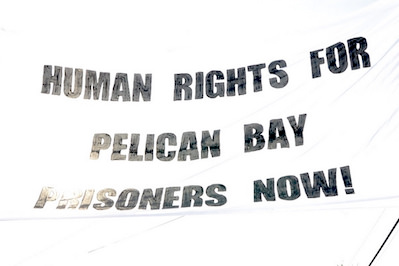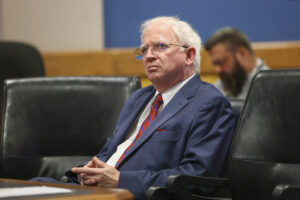Truthdiggers of the Week: Inmates and Lawyers Against Solitary Confinement
A 2011 hunger strike by California convicts attracted the attention of human rights advocates, and that led to an extraordinary alliance. If this group of lawyers and prisoners has its way, the barbaric conditions in our prisons will come to an end. A banner displayed at a rally held in Marin County, Calif., in support of inmates at Pelican Bay State Prison. (Daniel Arauz / CC BY-SA 2.0)
A banner displayed at a rally held in Marin County, Calif., in support of inmates at Pelican Bay State Prison. (Daniel Arauz / CC BY-SA 2.0)
The Constitution of the United States is supposed to protect citizens from cruel and unusual punishment inflicted by the criminal justice system, and, in the opinion of many experts, from government torture capable of inflicting lasting psychological damage. Thousands of inmates and a number of legal advocates are struggling to outlaw the practice of solitary confinement — in which inmates are isolated in a small room 23 hours a day, with only one hour per day for exercise, sometimes for longer than 10 years—in California and beyond.
The effort began in 2011, when inmates at Pelican Bay State Prison near Crescent City, Calif., sought through a hunger strike to bring mass attention to solitary confinement and other practices by the state’s Department of Corrections and Rehabilitation (CDCR). As well as causing outrage in some quarters of the public, the demonstration caught the attention of several civil rights lawyers.
The strike was over by the time Anne Weills, of the law firm Siegel & Yee in Oakland, and associates there and at the Center for Constitutional Rights agreed on a plan to support the inmates. But during the strike, Weills and her colleagues gained access to many of the convicts and soon developed both a detailed view of the practices being protested and the trust of the strike leaders. The lawyers formed a plan to challenge the state’s use of indefinite detention and solitary confinement on the premise that the practices violated the Eighth and 14th amendments of the U.S. Constitution—prohibiting cruel and unusual punishment and requiring due process, respectively—and in early 2012 won permission from the strike leaders to take their case to the U.S. District Court in Oakland.
One of those strike leaders was a former Aryan Brotherhood affiliate, Todd Ashker, 52. Ashker has spent more than 25 years in the Security Housing Unit (SHU), after being convicted of second-degree murder; while serving time at another prison for a burglary, he fatally stabbed another prisoner in 1987. His is a model case for the state’s standard argument for continuing solitary confinement: Some convicts must be held there because they are too dangerous to be housed among a prison’s general population.
In a column published last week, Truthdig’s Bill Blum, a former judge and defense attorney for convicts on death row, describes the SHU, which he saw during visits to Pelican Bay in the late 1980s. He called it a “high-tech hellhole, a science fiction nightmare come to life” where prisoners were subjected to an “unyielding routine of being held in a tiny, concrete, windowless cell with no access to other prisoners,” meals were slipped through a narrow steel slot and “access to books, writing materials and toiletries was severely restricted.” Cell doors are controlled electronically, and when guards speak to the inmates, they do so over an intercom.
“The monotony was broken only by an hour of daily exercise, also conducted alone, in a barren, concrete pen known as the ‘dog run’ that contained no gym equipment and offered only a narrow view of the sky through a metal mesh gate,” Blum wrote. The CDCR keeps nearly 1,200 of Pelican Bay’s inmates in this horrific environment.
A class-action lawsuit filed in the 1990s won rules that curtailed the use of force by correctional staff and called for the removal of prisoners with confirmed mental illnesses from the SHU. But the decision did no good for inmates like Ashker, who had no such diagnoses. Ashker started to study law and in 2009, with fellow inmate Danny Troxell, filed his own lawsuit, one aimed at overturning his and Troxell’s indefinite detention in the SHU.
The suit “gathered dust in district court” for two years, Blum tells us. Then, in a remarkable achievement, the inmates—many of whom were natural enemies because of their ties to rival ethnic gangs—learned to talk to each other through their cell doors. Their decision to co-operate among themselves—an effort involving more than 1,000 inmates in Pelican Bay and 6,000 inmates across the state—culminated in the strike that drew the attention of Weills and her associates in 2011.
As reported in Blum’s column, Weills described the experience of meeting these prisoners face-to-face as “mind blowing. Starving and weak, they were being subjected to further punishment with freezing air blasted into their cells while wearing only underwear. It became very clear that they were wedded to their nonviolent protest to win improved conditions for all those men in solitary confinement, whatever the personal costs to themselves.”
The lawsuit filed by Weills and other lawyers (and led by Jules Lobel, president of the Center for Constitutional Rights and a professor at the University of Pittsburgh School of Law) declares that the CDCR’s use of the SHU at Pelican Bay is unconstitutional. Further, it demands that prisoners who have spent more than 10 years in the SHU be released, that “the conditions of sensory deprivation and lack of social and human contact experienced by any remaining SHU inmates” be alleviated and that the need for the confinement of any remaining inmates in the SHU be reviewed.
Settlement negotiations are in progress, but the case remains relatively obscure. In his column, Blum urged California Attorney General Kamala Harris, who is seeking to replace Barbara Boxer in the U.S. Senate, to settle the case “as quickly and comprehensively as possible.”
Truthdig discussed the case with Blum by telephone a few days after his column was published.
“Solitary confinement isn’t an appropriate punishment anywhere, but especially in the U.S., which is supposed to be an enlightened nation governed by the best constitution the world has ever seen,” he said. “We have a provision in the Eighth Amendment which prohibits cruel and unusual punishment and that applies to federal and state governments by way of the 14th Amendment due process clause. A growing body of opinion believes that solitary confinement amounts to cruel and unusual punishment, particularly prolonged solitary confinement.
“The lawyers are not naive. They don’t think the plaintiffs are angels and they’re not suggesting that all of them go back to general population or that they be released immediately. There are degrees of confinement in between the extremes of housing in the SHU and the general population.”
Blum said that a number of lawyers think the evidence used to put many inmates in the SHU is “flimsy. … They have a horrible situation where people are encouraged to snitch on others, and it’s not always clear that they’re snitching honestly. They want to curry favor.”
“The best estimate is that that at any given time 80,000 American prisoners are held in solitary confinement. And I think that in the largest sense we have to think of SC as part and parcel of the garrison state that the U.S. has become, with the world’s largest prison population. That’s truly a disgrace and ties into questions of equality with a prison population where African-Americans are disproportionately represented.”
On the question of why solitary confinement is practiced in the U.S. at all, while many countries around the world are banning it, Blum said: “I think that there’s a lot of support for solitary confinement, as there’s a lot of support for locking people up. This war on crime’s been going on since Richard Nixon, who said we’ve got to fight criminals the way they fight us. It accelerated under [Bill] Clinton.”
“You couldn’t get elected in the U.S. unless you were tough on crime. I think it’s slowly changing, and the Black Lives Matter movement is to its credit pushing the issue to the forefront.”
As Blum notes in his column, outlawing solitary confinement would help many California officials burnish their liberal credentials. But more important, it would “restore the lives of hundreds of inmates who are housed under the most grinding and inhumane conditions.”
The inmates who united to spark outrage over solitary confinement and the lawyers who came to their aid are our Truthdiggers of the Week.
Your support matters…Independent journalism is under threat and overshadowed by heavily funded mainstream media.
You can help level the playing field. Become a member.
Your tax-deductible contribution keeps us digging beneath the headlines to give you thought-provoking, investigative reporting and analysis that unearths what's really happening- without compromise.
Give today to support our courageous, independent journalists.






You need to be a supporter to comment.
There are currently no responses to this article.
Be the first to respond.